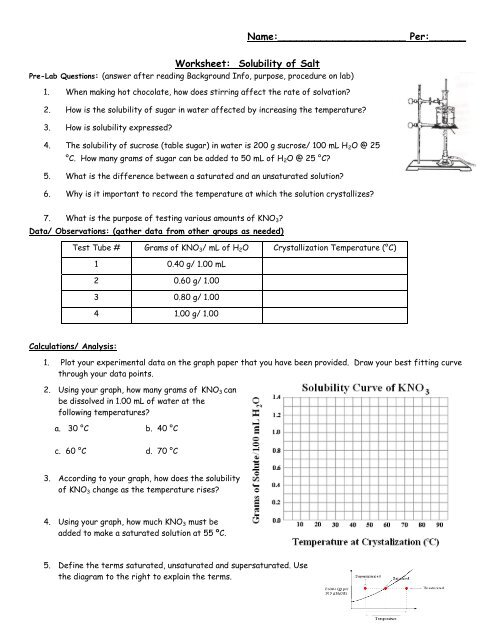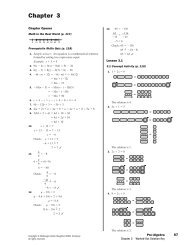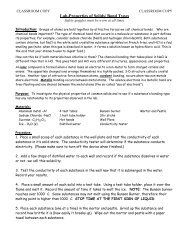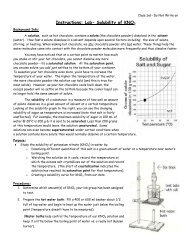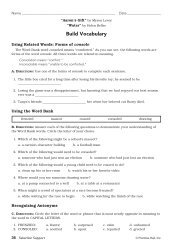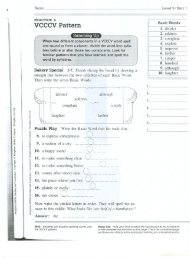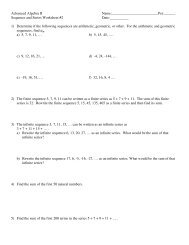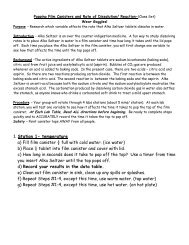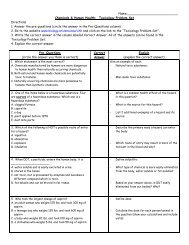Worksheet: Solubility of Salt
Worksheet: Solubility of Salt
Worksheet: Solubility of Salt
You also want an ePaper? Increase the reach of your titles
YUMPU automatically turns print PDFs into web optimized ePapers that Google loves.
Name:_____________________ Per:______<br />
<strong>Worksheet</strong>: <strong>Solubility</strong> <strong>of</strong> <strong>Salt</strong><br />
Pre-Lab Questions: (answer after reading Background Info, purpose, procedure on lab)<br />
1. When making hot chocolate, how does stirring affect the rate <strong>of</strong> solvation?<br />
2. How is the solubility <strong>of</strong> sugar in water affected by increasing the temperature?<br />
3. How is solubility expressed?<br />
4. The solubility <strong>of</strong> sucrose (table sugar) in water is 200 g sucrose/ 100 mL H 2 O @ 25<br />
°C. How many grams <strong>of</strong> sugar can be added to 50 mL <strong>of</strong> H 2 O @ 25 °C?<br />
5. What is the difference between a saturated and an unsaturated solution?<br />
6. Why is it important to record the temperature at which the solution crystallizes?<br />
7. What is the purpose <strong>of</strong> testing various amounts <strong>of</strong> KNO 3 ?<br />
Data/ Observations: (gather data from other groups as needed)<br />
Test Tube # Grams <strong>of</strong> KNO 3 / mL <strong>of</strong> H 2 O Crystallization Temperature (°C)<br />
1 0.40 g/ 1.00 mL<br />
2 0.60 g/ 1.00<br />
3 0.80 g/ 1.00<br />
4 1.00 g/ 1.00<br />
Calculations/ Analysis:<br />
1. Plot your experimental data on the graph paper that you have been provided. Draw your best fitting curve<br />
through your data points.<br />
2. Using your graph, how many grams <strong>of</strong> KNO 3 can<br />
be dissolved in 1.00 mL <strong>of</strong> water at the<br />
following temperatures?<br />
a. 30 °C b. 40 °C<br />
c. 60 °C d. 70 °C<br />
3. According to your graph, how does the solubility<br />
<strong>of</strong> KNO 3 change as the temperature rises?<br />
4. Using your graph, how much KNO 3 must be<br />
added to make a saturated solution at 55 ºC.<br />
5. Define the terms saturated, unsaturated and supersaturated. Use<br />
the diagram to the right to explain the terms.
Questions for Discussion<br />
Use the solubility curve provided on the right to determine<br />
the answers to the following questions:<br />
1. Why do you think the temperatures on the graph only go<br />
from 0 ºC to 100 ºC?<br />
2. How many grams <strong>of</strong> solute are required to saturate 100<br />
g <strong>of</strong> water in each <strong>of</strong> the following solutions?<br />
(FYI: 100 g H 2 O = 100 mL)<br />
a. KClO 3 at 90ºC b. NaNO 3 at 10ºC<br />
c. NH 3 at 20 ºC d. NH 4 Cl at 70ºC<br />
3. Which substance is most soluble at 60 ºC?<br />
4. Which substance’s solubility changes the most from 0 ºC<br />
to 100 ºC?<br />
5. Which substance’s solubility changes the least from 0 ºC<br />
to 100 ºC?<br />
6. At what temperature does KI have a solubility <strong>of</strong> 150 g/ 100 mL water?<br />
3. What is each <strong>of</strong> the solutions below: saturated, unsaturated or supersaturated? All <strong>of</strong> the solutes are mixed<br />
with 100 mL <strong>of</strong> water.<br />
a. 40 g <strong>of</strong> NaCl at 50 ºC b. 30 g <strong>of</strong> NH 3 at 30 ºC<br />
c. 70 g <strong>of</strong> KCl at 20 ºC d. 80 g <strong>of</strong> KNO 3 at 60 ºC<br />
4. Which solute is least affected by the temperature changes?<br />
5. How does the solubility <strong>of</strong> all “gases” (NH 3 , and Ce 2 (SO 4 ) 3 ) change with increased temperatures? Can you think<br />
<strong>of</strong> a reason why this might be so?<br />
6. You have a solution <strong>of</strong> KClO 3 containing 4 g at 65 ºC. How many additional grams <strong>of</strong> solute must be added to it,<br />
to make the solution saturated?


